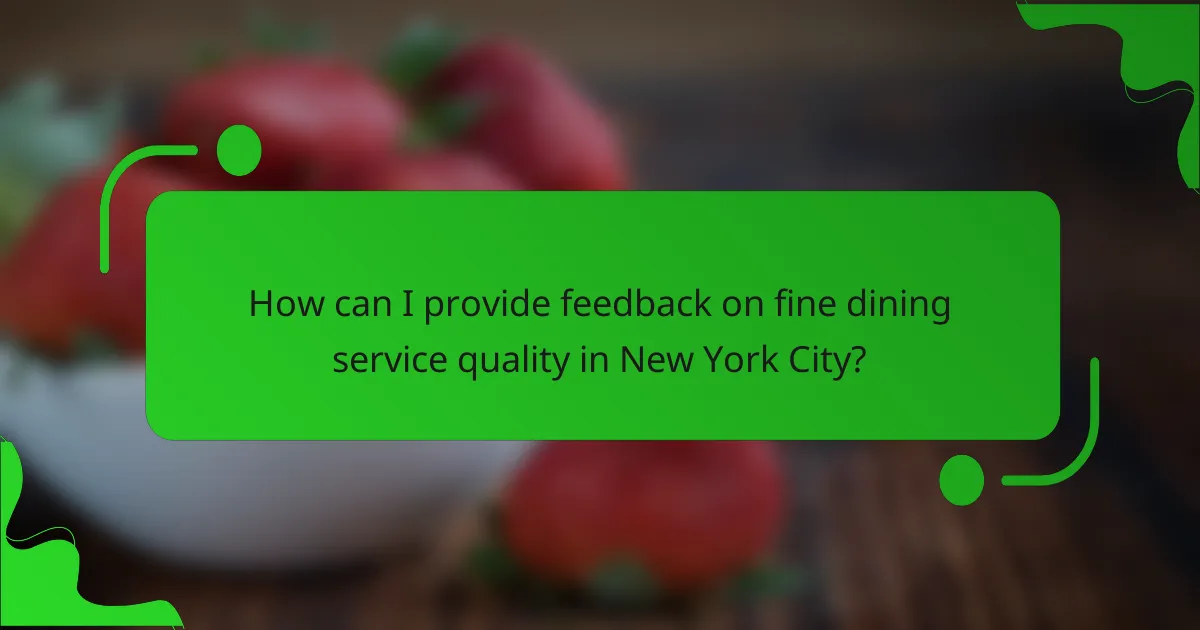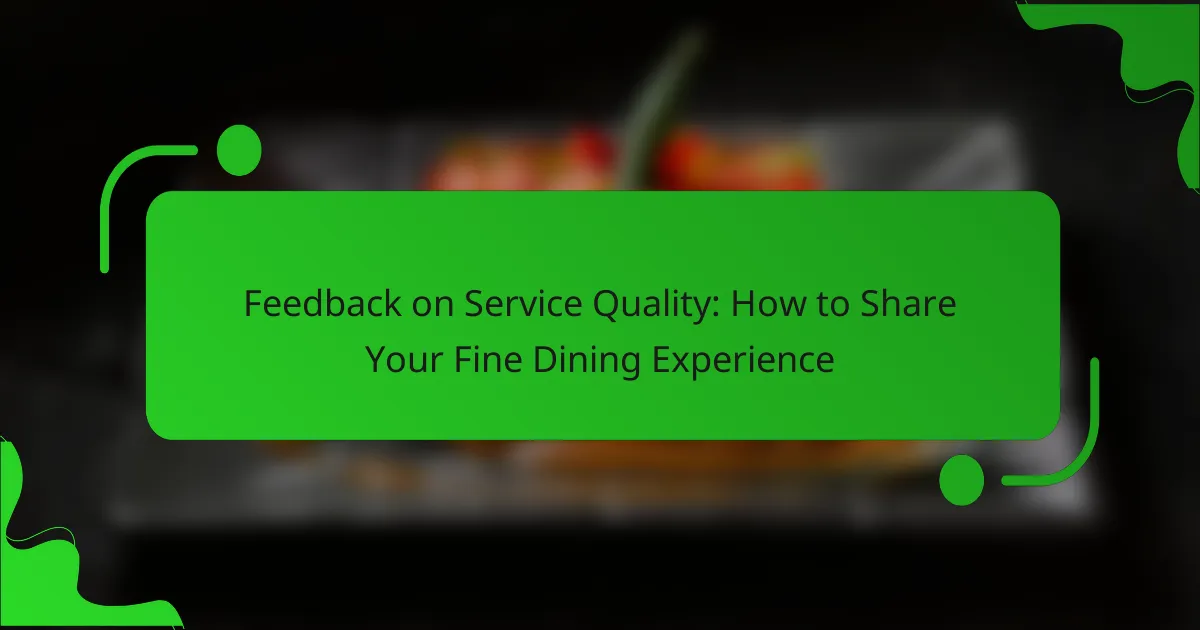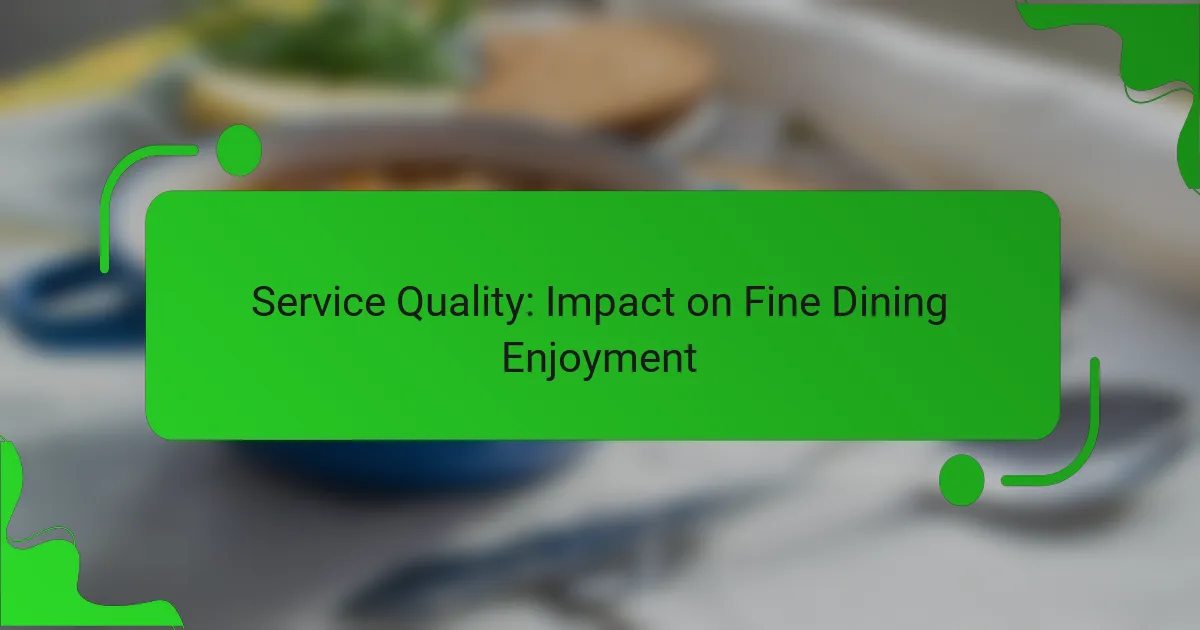Sharing your feedback on fine dining service quality is essential for both diners and restaurant owners. By utilizing online review platforms, direct communication, or social media, you can effectively convey your experience and insights. Focus on key aspects such as staff professionalism, timeliness, and food presentation to provide constructive feedback that can enhance future dining experiences.

How can I provide feedback on fine dining service quality in New York City?
Providing feedback on fine dining service quality in New York City can be done through various channels, each offering unique benefits. Consider using online review platforms, direct communication with restaurant management, or social media to share your experience effectively.
Online review platforms
Online review platforms like Yelp, TripAdvisor, and Google Reviews are popular ways to share your fine dining experience. These platforms allow you to rate your visit and provide detailed comments about service quality, ambiance, and food. Aim for a balanced review that highlights both positives and areas for improvement.
When writing your review, be specific about your experience. Mention the server’s attentiveness, the speed of service, and any standout dishes. Including photos can also enhance your review and help other diners make informed decisions.
Direct feedback to restaurant management
Directly communicating with restaurant management can be one of the most effective ways to provide feedback on service quality. If you have concerns or compliments, consider speaking to the manager during your visit or sending an email afterward. This approach allows for immediate dialogue and can lead to prompt resolutions.
When providing feedback, be clear and concise. State your experience and suggest improvements if necessary. Many restaurants appreciate constructive criticism and may offer compensation or a follow-up to show they value your input.
Social media sharing
Sharing your fine dining experience on social media platforms like Instagram, Facebook, or Twitter can reach a wide audience. Use relevant hashtags and tag the restaurant to increase visibility. This method not only informs your followers but also provides the restaurant with public feedback.
When posting, consider sharing a brief review along with photos of your meal or the dining atmosphere. Engaging with the restaurant’s social media account can also foster a positive relationship and encourage them to respond to your feedback.

What are the best platforms for sharing dining experiences?
The best platforms for sharing dining experiences include Yelp, Google Reviews, and Tripadvisor. Each platform offers unique features that cater to different audiences and can significantly impact how your feedback is perceived by potential diners.
Yelp
Yelp is a popular platform known for its extensive user-generated reviews and ratings of restaurants. Users can create detailed reviews, upload photos, and rate their experiences on a five-star scale, making it easy for others to gauge the quality of a dining establishment.
When sharing your experience on Yelp, focus on specific aspects such as service, ambiance, and food quality. Including personal anecdotes can enhance your review’s authenticity and help others relate to your experience.
Be mindful of Yelp’s community guidelines, which discourage fake reviews and require honesty. Engaging with other users by responding to comments can also improve your visibility on the platform.
Google Reviews
Google Reviews allows users to leave feedback directly on Google Maps and search results, making it highly accessible. This platform integrates seamlessly with Google services, meaning your review can influence a restaurant’s visibility in search results.
When writing a Google Review, keep it concise and to the point. Highlight key elements of your dining experience and consider adding a star rating. Since many people rely on Google for quick information, clarity is crucial.
Remember that Google Reviews are publicly visible, so maintain professionalism in your feedback. Avoid using offensive language, and focus on constructive criticism to help both the restaurant and future diners.
Tripadvisor
Tripadvisor is widely recognized for its travel-related reviews, including dining experiences. This platform allows users to rate restaurants, share photos, and provide detailed reviews that can help travelers make informed choices.
When posting on Tripadvisor, consider the audience, which often includes tourists looking for local dining options. Your review should reflect the overall experience, including service, food quality, and value for money.
Engage with the community by answering questions from other users or responding to restaurant management. This interaction can enhance your credibility and encourage more diners to consider your feedback when choosing where to eat.

What specific aspects of service should I evaluate?
When evaluating service quality in fine dining, focus on staff professionalism, timeliness of service, and food presentation. These elements significantly impact your overall dining experience and can help you articulate your feedback effectively.
Staff professionalism
Staff professionalism encompasses the demeanor, knowledge, and attentiveness of the restaurant personnel. Observe how they interact with you and other guests, ensuring they are courteous and knowledgeable about the menu and wine pairings.
Look for signs of training, such as proper etiquette and the ability to answer questions confidently. A well-trained staff should be able to make recommendations and handle any issues gracefully.
Timeliness of service
Timeliness of service refers to how quickly your orders are taken, food is served, and requests are fulfilled. Ideally, you should expect your initial order to be taken within a few minutes and food to arrive within a reasonable timeframe, typically around 15-30 minutes, depending on the complexity of the dishes.
Pay attention to how the staff manages pacing throughout the meal. A good dining experience will have a comfortable flow, allowing you to enjoy each course without feeling rushed or neglected.
Food presentation
Food presentation is crucial in fine dining, as it enhances the overall experience and reflects the restaurant’s attention to detail. Dishes should be visually appealing, with careful arrangement and vibrant colors that entice the diner.
Consider how the plating complements the flavors and ingredients of the dish. A well-presented meal not only tastes good but also creates a memorable impression, making it easier to provide specific feedback on your experience.

How can I structure my feedback effectively?
To structure your feedback on a fine dining experience effectively, focus on clarity and organization. Start with a clear introduction, followed by specific examples, and conclude with a summary of your main points.
Use specific examples
When providing feedback, specific examples help illustrate your points clearly. For instance, mention particular dishes you enjoyed or aspects of the service that stood out, such as the attentiveness of the staff or the ambiance of the restaurant.
Instead of saying “the food was good,” specify what you liked, such as “the lobster bisque was rich and flavorful.” This level of detail not only makes your feedback more useful but also helps the restaurant understand what they are doing well.
Be constructive and polite
Constructive feedback is essential for fostering improvement. Frame your comments in a way that encourages positive change, using phrases like “I suggest” or “it would be great if.” This approach shows that you care about the establishment’s growth.
Maintain a polite tone throughout your feedback. Even if you had a negative experience, expressing your thoughts respectfully can lead to a more productive dialogue with the restaurant management.
Focus on both positives and negatives
Balancing your feedback by highlighting both positives and negatives provides a comprehensive view of your experience. Acknowledge what the restaurant did well, such as excellent wine pairings or a welcoming atmosphere, while also addressing areas for improvement, like long wait times or dish temperature.
This balanced approach not only makes your feedback more credible but also helps the restaurant identify strengths to build on and weaknesses to address. Aim for a ratio of about 2:1, where you mention two positive aspects for every negative point, ensuring a fair assessment.

What are the common challenges in giving feedback?
Providing feedback on service quality in fine dining can be challenging due to various factors. Common issues include fear of backlash, uncertainty about the impact of feedback, and difficulty in articulating experiences effectively.
Fear of backlash
Many diners hesitate to share their experiences due to fear of negative repercussions, such as being treated poorly in future visits. This concern is particularly prevalent in fine dining establishments where relationships with staff may feel more personal.
To mitigate this fear, consider providing feedback anonymously through online platforms or comment cards. This approach can help you express your thoughts without the worry of immediate consequences.
Uncertainty about impact
Diners often question whether their feedback will lead to any meaningful changes. This uncertainty can stem from past experiences where feedback seemed to go unnoticed or unacknowledged.
To enhance the likelihood of your feedback being taken seriously, be specific about your experience and suggest actionable improvements. For instance, instead of saying “the service was slow,” you might say, “the wait time for our main course exceeded 40 minutes, which affected our overall experience.”
Difficulty articulating experiences
Expressing thoughts about a fine dining experience can be challenging, especially when trying to convey emotions and nuances. Many diners struggle to find the right words to describe their feelings about service quality.
To improve articulation, consider jotting down your thoughts immediately after the meal. Focus on key aspects like service speed, staff demeanor, and food quality. This practice can help you organize your feedback clearly and effectively when it comes time to share it.



